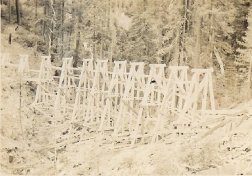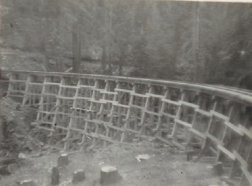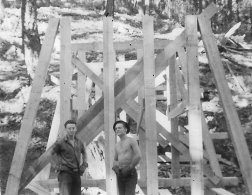Summers of 1938 and 1939 I was assigned to the bridge crew, to build new trestles and maintain old ones. Starting this year the previous
bridge crew under Henry Ward was sent to Pino Grande to build cabins. A new boss was hired, a young man probably in his 30s, and very capable.
There were about 4 of us on the crew plus the boss, but when we constructed a new bridge, the survey crew joined us, for as well as doing
construction, they also laid out the location of the bents and their elevations. Gunnar Forsbeck, a Swede, as you might have guessed was the
surveyor, and with a crew of 4 or so had already laid out the route of the railroad. I might add that Gunnar was the California State Cross-country
ski champion in 1936. Most of us on these 2 crews were college students favored by having summer jobs and getting 60 cents and hour.
 Partially completed, next step is stringers. |
 Completed trestle circa 1938 or '39. |
After the location of the footings of the bridge had been laid out, we prepared a level bed for the full length of that sill. It was shovel
and pick job, sometimes aided by a little dynamite. The vertical post are called "plumb posts" measuring 10" x 10", the slanting one on the side are
"batter posts" the same size timbers. The horizontal pieces are either sills or caps, also 10" x 10". The stringers connecting the bents were about
8" x 16" upon which the rail "ties" were nailed. All the bracing boards were 2" x 10" as I recall. Cedar pieces were placed under the bottom sills
to protect the sills from moisture, and I think the rest of the timbers were red fir. Red fir is pretty much the equivalent of douglas fir, which is
the main timber of Oregon and Washington. It could be produced up there cheaper than we could do it, so we only used it for our own construction.
We used 2 sizes of nails, or probably they should be called "spikes" 60 penny and 80 penny, which means 6 and 8 inches long. The hammers were
probably close to 2 pounds, and though I don't recall, we must have worn tool belts, for we had to have our hands free to manipulate the timbers and
climb all over the structures. Other tools included levels, and pry bars. The timbers were all wet which means they were twice as heavy as dry ones,
but that was favorable for it made much easier nailing.
Well, how did we get the timbers out in the ravines? We used a "tight line". This was a cable, or more properly, called wire rope, strung through
a block (pulley) high up in a tree at the beginning of the bridge with one end attached to a "cat" or a locomotive, and the other end fastened across
the ravine to a good solid tree at a lower elevation. A "wheel pulley" (my designation because I don't know its correct name) rode on this cable and
hanging from it was a short cable to which the timbers could be attached. By tightening the tight line, the timbers could be lifted from the area where
they were sawn and ferried out to the right spot by gravity where the line was relaxed and the timber was dropped in approximately the right place.
A rope attached to this pulley controlled the distance the timbers went, and after placing the piece in place, the pulley was pulled back to its base.
None of this was easy, but we considered it fun, and because we were young bucks we cut the construction time in half compared to the old crew.
We had but one member of the old crew and he got in our way most of the time. When he became too big a problem, we would hide his favorite hammer,
which kept him searching for quite a while. The touchiest part of the job was putting the stringers in place. We placed two 3 x 12 red fir planks
between the bents; one to walk on and one to ferry the stringer out on a dolly. The dolly was removed and then the stringer had to be rolled or
shoved into position with only 5 inches on each end to play with. Four of these were toe-nailed into position , 2 under each rail location. Ties
were then laid and toe-nailed, and it was then the steel gangs job to lay the rail.

All this happened about 70 years ago and if I have presented a bit of mis-information, forgive me. It was a fun life up there. I had been a gymnast
in high school and the height and the clambering didn't bother me. In the above photo, Joe Cola is on the left. His father
was once camp boss, and his widow, Beverly, lived in Smith Flat the last time I saw her. Joe studied aeronautical engineering at Sacramento Junior College
and later had a repair shop of some sort around Placerville. The gentleman baring his chest was Phil English. He had been a student at Cal Poly in
San Luis Obispo, and worked around Placerville the rest of his life. My life went in another direction and though I occasionally passed through Placerville,
I was never able to contact them. This so often happens with old friends.
Thanks for listening to me, I'll write some more tales later on.
George Parker
